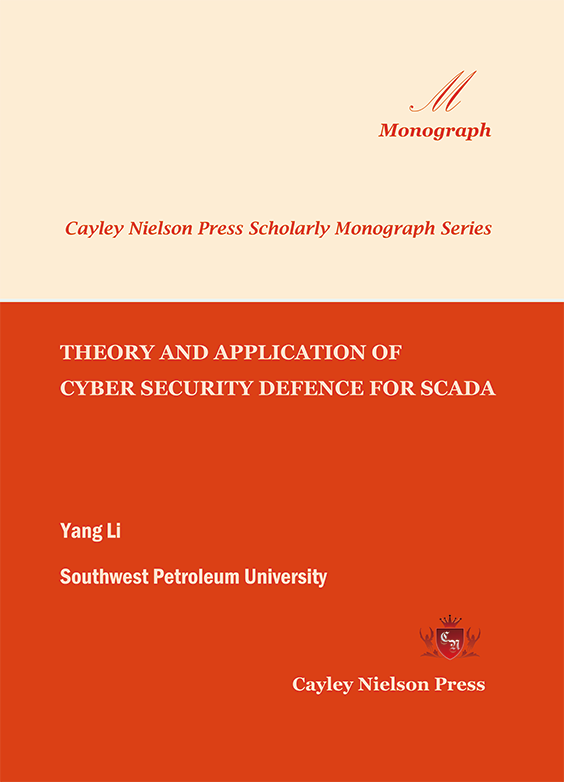
THEORY AND APPLICATION OF CYBER SECURITY DEFENCE FOR SCADA

Yang Li
Southwest Petroleum University
Copyright © 2022 by Cayley Nielson Press, Inc.
ISBN: 978-1-957274-00-3
Cayley Nielson Press Scholarly Monograph Series Book Code No.: 212-01-1
US$172.60
Contents
1.1 Introduction 1
1.2 Related Work 3
1.3 Formal Description of Factor State Space 5
1.3.1 Factor and Factor Space 5
1.3.2 Factors State Space Based on Object 6
1.3.3 Knowledge Factor Expression 6
1.3.4 Formal Description of Analysis Factor Neuron 8
1.3.5 Formal Description of Analog Factor Neuron 9
1.3.6 Formal Description of Combined Factor Neurons 10
1.4 Factor Neuron Network Model Based on Factor Space 11
1.4.1 Threshold Neuron Model Unrelated to Time 13
1.4.2 Linear Neuron Model Unrelated to Time 14
1.4.3 General Expression of Linear Neuron Model Unrelated to Time 14
1.5 Factor Neuron Model Based on Variable Weight 17
1.6 Architecture Model of Fnn-Based Scada Network Defence System 18
1.6.1 Logic Structure of FNN-based SCADA Network Defence System 18
1.6.2 Working Process 19
1.7 Simulation Experiment on Scada Network Attack and Defence 21
1.8 Conclusions 25
Chapter 2 A Supervisory Control and Data Acquisition Network Security Attack Recognition Method Based on Multi-Agent 26
2.1 Introduction 26
2.2 The Advantages of Multi Agent Systems in SCADA Network Security Defense 28
2.3 Multi-Agent Structure of SCADA Security Defense 29
2.3.1 Logic structure 29
2.3.2 Work flow of SCADA-IDS-AN 32
2.4 SCADA Network Attack Recognition Model Based on Data Mining 34
2.4.1 Neural network recognition model 34
2.4.2 Improved BP Algorithm 38
2.5 Simulation Experiment 42
2.5.1 Neural Network Structure 43
2.5.2 Experimental Results and Analysis 44
2.6 Conclusions 49
Chapter 3 A Security Architecture Model of Oil and Gas SCADA Network Based on Multi-Agent 50
3.1 Introduction 50
3.2 Related Works 52
3.3 SCADA network security defense architecture based on multi-Agent 54
3.3.1 Security defense formal description based on Multi-agent 54
3.4 Logic model of SCADA security overall framework 57
3.4.1 Structure model 57
3.4.2 Response method for multi-agent defense model 61
3.5 SCADA network security attack and defense simulation based on multi Agent 62
3.5.1 Attack simulation 63
3.5.2 Defense Simulation 66
3.6 Experimental Simulation Results 69
3.7 Conclusions 72
Chapter 4 A New Formal Description Model of Network Attacking and Defence Knowledge of Oil and Gas Field SCADA System 73
4.1 Introduction 73
4.2 Related Work 74
4.3 The Formal Description Model of SCADA Network Attacking and Defence Knowledge 75
4.3.1 Factors State Space Based on Object 75
4.3.2 SCADA Formal Description of Network Attack and Defense Factors Expression 76
4.3.3 Behavior of a Collection of Objects of Things Definition of Equivalence Class Partition 79
4.4 Attack and Defense Task Model 83
4.4.1 The knowledge model of network attacks 83
4.4.2 Experimental Verification 86
4.5 Conclusion 87
References 88
Readership
This book should be useful for students, scientists, engineers and professionals working in the areas of optoelectronic packaging, photonic devices, semiconductor technology, materials science, polymer science, electrical and electronics engineering. This book could be used for one semester course on adhesives for photonics packaging designed for both undergraduate and graduate engineering students.
